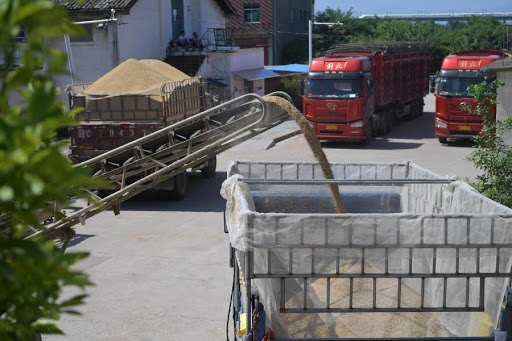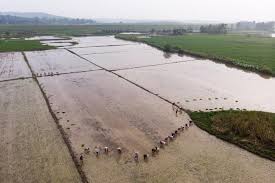
China makes multi-faceted efforts to ensure grain security
Beijing: Since mid-July, Huang Xiaoping has been busy working in his 110-hectare paddy field, harvesting early rice and sowing for the next season.
Huang also runs a rental business involving farm machinery in a village near the Dongting Lake, China’s second-largest freshwater lake in the central Hunan Province, helping local farmers during the “double rush” season.
“We need to fight the current flood and strengthen the embankments,” Huang said.

According to China’s Ministry of Emergency Management, rain-triggered floods had affected some 54.8 million people in 27 provincial-level regions as of late July, causing direct economic losses of 144.43 billion yuan (about 20.8 billion U.S. dollars).
Restrictions on food exports and panic hoarding in some countries and regions, as well as rampant desert locust, have adversely affected food production.

“The State of Food Security and Nutrition in the World 2020” report released by five agencies, including the Food and Agriculture Organization of the United Nations, projected that COVID-19 could push up to 132 million people into starvation globally this year.
Though downpours and floods destroyed vast stretches of farmland and agricultural facilities, flood control situation in the hard-hit provinces of Jiangxi and Anhui is improving as the water level in major waterways continues to recede.
The flood control and drought relief headquarters of the two provinces have successively downgraded their emergency response level since early August.
In the face of the floods, the Chinese provinces have been mobilizing resources, using upgraded technology, and providing material support to ensure grain security and make up for losses in production.
For farmers like Huang, time is the essence. In the low-lying township of Liaonan near the Poyang Lake in Jiangxi, Wu Baolin was busy sowing seeds of late rice with two workers. He saw some two hectares of his crops damaged in the floods.
“The harvest is finally guaranteed even if it might be delayed,” Wu said, adding that there is no time to lose when it comes to growing crops.
In Anhui, replantation of single-cropping rice has been carried out on every piece of farmland where the floodwater has receded. As of early August, more than 100,000 hectares of crops had been resowed, accounting for 38 percent of Anhui’s total area of farmland needing replantation, according to the provincial department of agriculture and rural affairs.
China’s total grain output consists of three parts — early rice, summer grain and autumn production. Summer grain is the first season of the annual grain production, which accounts for more than a fifth of the annual output.
Various measures have been adopted by authorities to ensure stable grain output amid efforts to control the COVID-19 epidemic, such as fully implementing support policies like the minimum purchase price for rice and wheat and improving the quality of spring plowing.

As the world’s top food producer and consumer, China saw its grain output reach a record high of 664 million tonnes last year, the 16th bumper year in a row.
The country’s summer grain output reached a historic high of 142.81 million tonnes this year, up 0.9 percent from last year, according to the National Bureau of Statistics.
Autumn grain crops, which include corn, middle- and late-season rice and soybean, account for the bulk of China’s grain production. The total plantation area of autumn grain has increased steadily this year and the crops are growing fine, thus laying a solid foundation for another bumper harvest.
In order to strengthen the prevention and control of plant diseases and pest, the Ministry of Agriculture and Rural Affairs has called for ramped up efforts against the invasion of fall armyworms, rice planthoppers and rice leaf rollers, the three migratory species of pest that threaten autumn grain production.
Pan Wenbo, a crop management official with the ministry, said despite severe floods in parts of the country, crop farming remains stable overall.
Efforts have been made in grain reserves and circulation, grain purchasing, local grain reserves, and improving the capacity for emergency supply.
The Ministry of Emergency Management and the Ministry of Finance have earmarked 935 million yuan in disaster relief funds to aid local disaster relief work in provinces including Jiangxi, Hubei, Hunan and Anhui.
Agricultural authorities have built up a 50,000-tonne seed reserve to cope with disasters and crop failures, with more than 7,000 tonnes of seeds already handled to support crop farming for 320,000 hectares of farmland.
According to the department of agriculture and rural affairs in Hunan, the overall flood situation in the province is relatively stable compared with previous years, and the safety of grain production remains within a controllable range.
Wu Liquan, professor at Anhui Agricultural University, said the flooding is unlikely to cause a sharp decrease in grain production since the reinforced dikes and embankments along the Yangtze River have made farmlands safer. Besides, improved irrigation and drainage facilities coupled with advanced agricultural technologies, have further improved safety.
In Hubei, more than 4,000 sci-tech workers from agricultural research institutions have been providing online and offline technical guidance to local farmers, donating more than 700 tonnes of farming supplies and distributing some 300,000 copies of various technical materials.
“We will continue to listen to the needs of farmers and enterprises, help them solve problems and better serve the recovery of agricultural production,” said You Aiqing, a rice breeding expert and deputy head of the Hubei Academy of Agricultural Sciences.
